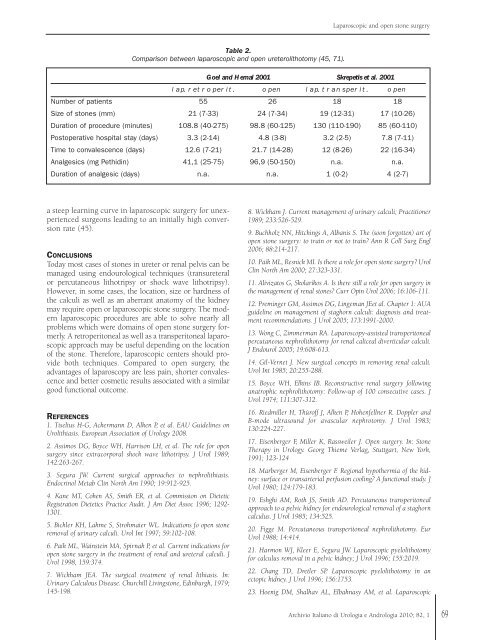Summary - Salute per tutti
Summary - Salute per tutti
Summary - Salute per tutti
- No tags were found...
Create successful ePaper yourself
Turn your PDF publications into a flip-book with our unique Google optimized e-Paper software.
Laparoscopic and open stone surgeryTable 2.Comparison between laparoscopic and open ureterolithotomy (45, 71).Goel and H emal 2001 Skrepetis et al. 2001l ap. r et r o <strong>per</strong> i t . o pen l ap. t r an s<strong>per</strong> i t . o penNumber of patients 55 26 18 18Size of stones (mm) 21 (7-33) 24 (7-34) 19 (12-31) 17 (10-26)Duration of procedure (minutes) 108.8 (40-275) 98.8 (60-125) 130 (110-190) 85 (60-110)Posto<strong>per</strong>ative hospital stay (days) 3.3 (2-14) 4.8 (3-8) 3.2 (2-5) 7.8 (7-11)Time to convalescence (days) 12.6 (7-21) 21.7 (14-28) 12 (8-26) 22 (16-34)Analgesics (mg Pethidin) 41,1 (25-75) 96,9 (50-150) n.a. n.a.Duration of analgesic (days) n.a. n.a. 1 (0-2) 4 (2-7)a steep learning curve in laparoscopic surgery for unex<strong>per</strong>iencedsurgeons leading to an initially high conversionrate (45).CONCLUSIONSToday most cases of stones in ureter or renal pelvis can bemanaged using endourological techniques (transureteralor <strong>per</strong>cutaneous lithotripsy or shock wave lithotripsy).However, in some cases, the location, size or hardness ofthe calculi as well as an aberrant anatomy of the kidneymay require open or laparoscopic stone surgery. The modernlaparoscopic procedures are able to solve nearly allproblems which were domains of open stone surgery formerly.A retro<strong>per</strong>itoneal as well as a trans<strong>per</strong>itoneal laparoscopicapproach may be useful depending on the locationof the stone. Therefore, laparoscopic centers should provideboth techniques. Compared to open surgery, theadvantages of laparoscopy are less pain, shorter convalescenceand better cosmetic results associated with a similargood functional outcome.REFERENCES1. Tiselius H-G, Ackermann D, Alken P, et al. EAU Guidelines onUrolithiasis. European Association of Urology 2008.2. Assimos DG, Boyce WH, Harrison LH, et al. The role for opensurgery since extracorporal shock wave lithotripsy. J Urol 1989;142:263-267.3. Segura JW. Current surgical approaches to nephrolithiasis.Endocrinol Metab Clin North Am 1990; 19:912-925.4. Kane MT, Cohen AS, Smith ER, et al. Commission on DieteticRegistration Dietetics Practice Audit. J Am Diet Assoc 1996; 1292-1301.5. Bichler KH, Lahme S, Strohmaier WL. Indications fo open stoneremoval of urinary calculi. Urol Int 1997; 59:102-108.6. Paik ML, Wainstein MA, Spirnak P, et al. Current indications foropen stone surgery in the treatment of renal and ureteral calculi. JUrol 1998, 159:374.7. Wickham JEA. The surgical treatment of renal lithiasis. In:Urinary Calculous Disease. Churchill Livingstone, Edinburgh, 1979;145-198.8. Wickham J. Current management of urinary calculi; Practitioner1989; 233:526-529.9. Buchholz NN, Hitchings A, Albanis S. The (soon forgotten) art ofopen stone surgery: to train or not to train? Ann R Coll Surg Engl2006; 88:214-217.10. Paik ML, Resnick MI. Is there a role for open stone surgery? UrolClin North Am 2000; 27:323-331.11. Alivizatos G, Skolarikos A. Is there still a role for open surgery inthe management of renal stones? Curr Opin Urol 2006; 16:106-111.12. Preminger GM, Assimos DG, Lingeman JEet al. Chapter 1: AUAguideline on management of staghorn calculi: diagnosis and treatmentrecommendations. J Urol 2005; 173:1991-2000.13. Wong C, Zimmerman RA. Laparoscopy-assisted trans<strong>per</strong>itoneal<strong>per</strong>cutaneous nephrolithotomy for renal caliceal diverticular calculi.J Endourol 2005; 19:608-613.14. Gil-Vernet J. New surgical concepts in removing renal calculi.Urol Int 1985; 20:255-288.15. Boyce WH, Elkins IB. Reconstructive renal surgery followinganatrophic nephrolithotomy: Follow-up of 100 consecutive cases. JUrol 1974; 111:307-312.16. Riedmiller H, Thüroff J, Alken P, Hohenfellner R. Doppler andB-mode ultrasound for avascular nephrotomy. J Urol 1983;130:224-227.17. Eisenberger F, Miller K, Rassweiler J. Open surgery. In: StoneTherapy in Urology. Georg Thieme Verlag, Stuttgart, New York,1991; 123-12418. Marberger M, Eisenberger F. Regional hypothermia of the kidney:surface or transarterial <strong>per</strong>fusion cooling? A functional study. JUrol 1980; 124:179-183.19. Eshghi AM, Roth JS, Smith AD. Percutaneous trans<strong>per</strong>itonealapproach to a pelvic kidney for endourological removal of a staghorncalculus. J Urol 1985; 134:525.20. Figge M. Percutaneous trans<strong>per</strong>itoneal nephrolithotomy. EurUrol 1988; 14:414.21. Harmon WJ, Kleer E, Segura JW. Laparoscopic pyelolithotomyfor calculus removal in a pelvic kidney; J Urol 1996; 155:2019.22. Chang TD, Dretler SP. Laparoscopic pyelolithotomy in anectopic kidney. J Urol 1996; 156:1753.23. Hoenig DM, Shalhav AL, Elbahnasy AM, et al. LaparoscopicArchivio Italiano di Urologia e Andrologia 2010; 82, 169
















